The Skoda Octavia is equipped with two independent brake systems: working and parking (Fig. 1122). The first, equipping with a hydraulic drive, provides braking when the car is moving, the second slows down the car in the parking lot. The working brake system of the Skoda Octavia is dual-circuit, with a diagonal connection of the brake mechanisms of the front and rear wheels. One hydraulic drive circuit ensures the operation of the right front and left rear brake mechanisms, the other - the left front and right rear.
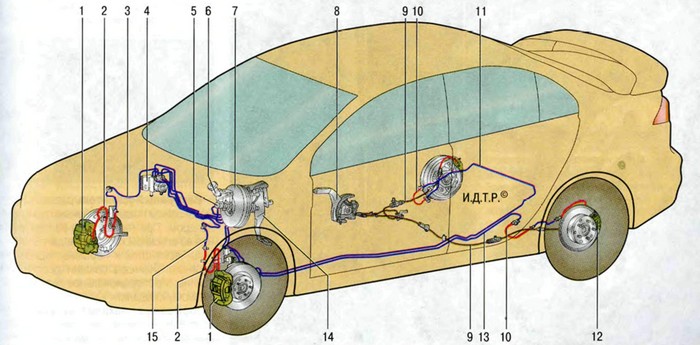
Rice. 1122. Arrangement of brake elements of Skoda Octavia:
1 - front wheel brake mechanism; 2 - hoses of the brake mechanisms of the front wheels; 3 - pipeline of the brake mechanism of the right front wheel; 4 - hydroelectronic block ABS; 5 main brake cylinder; 6 - reservoir of the main brake cylinder; 7 - vacuum amplifier; 8 - parking brake drive lever; 9 - cables (front and rear) of the parking brake drive; 10 - hoses of the brake mechanisms of the rear wheels; 11 - pipeline of the brake mechanism of the right rear wheel; 12 - brake mechanism of the rear wheel; 13 - pipeline of the brake mechanism of the left rear wheel; 14 - brake pedal; 15 - pipeline of the brake mechanism of the left front wheel.
If one of the circuits of the service brake system fails, another circuit is used to stop the vehicle with sufficient efficiency.
The hydraulic drive includes the main brake cylinder 6 (Fig. 1123), the vacuum booster 5, the hydro-electronic block of the anti-lock braking system, the brake mechanisms of the front and rear wheels together with the working cylinders, pipelines.
The parking brake system is equipped with a cable drive to the rear wheel brakes.
The brake mechanisms of the front wheels are disc, with automatic adjustment of the gap between the brake pads 2 (Fig. 1124) and the brake disc 7. The inner shoe is attached with clamps to the working brake cylinder. The outer shoe is attached with clamps to the bracket 1.
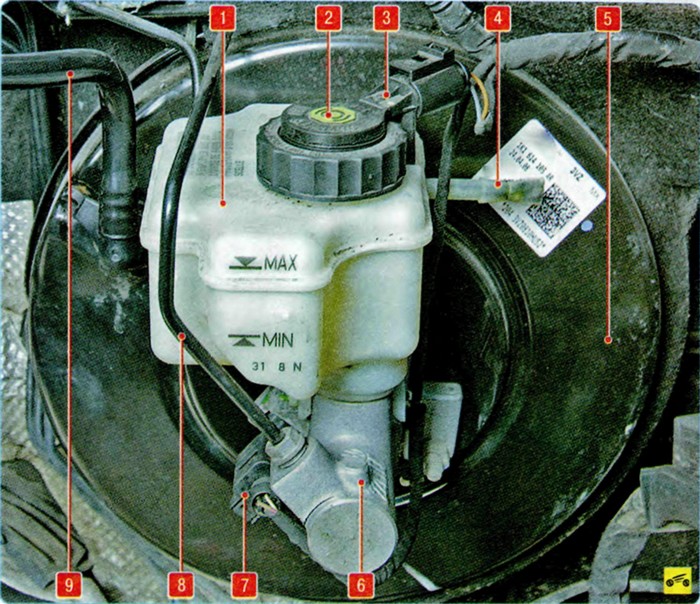
Rice. 1123. The main brake cylinder with a vacuum booster:
1 - a reservoir of the main brake cylinder; 2 - tank cap with brake fluid level sensor; 3 - block of the wiring harness of the brake fluid level sensor; 4 - fitting for connecting the supply hose of the clutch hydraulic drive (in the variant); 5 - vacuum amplifier; 6 - main brake cylinder; 7 - sensor for turning on the brake light (since October 2005); 8 - high pressure pipeline; 9 - vacuum hose.
A piston with a sealing ring is installed in the cavity of the wheel cylinder. Due to the elasticity of this ring, an optimal clearance is maintained between the pads and the ventilated disc, the surface of which is protected by the brake shield. When braking, the piston, under the action of fluid pressure, presses the inner pad against the disc, the reaction force moves the caliper on the fingers and the outer pad is also pressed against the disc, while the pressing force of the pads is the same. When releasing the piston, due to the elasticity of the sealing ring, it is removed from the pad - a small gap forms between the pads and the disc.
The main brake cylinder with fig. 1122 type "tandem" hydraulic brake actuator Skoda Octavia consists of two separate chambers connected to independent hydraulic circuits. The first chamber is connected to the right front and left rear brake mechanisms, the second - to the left front and right rear.
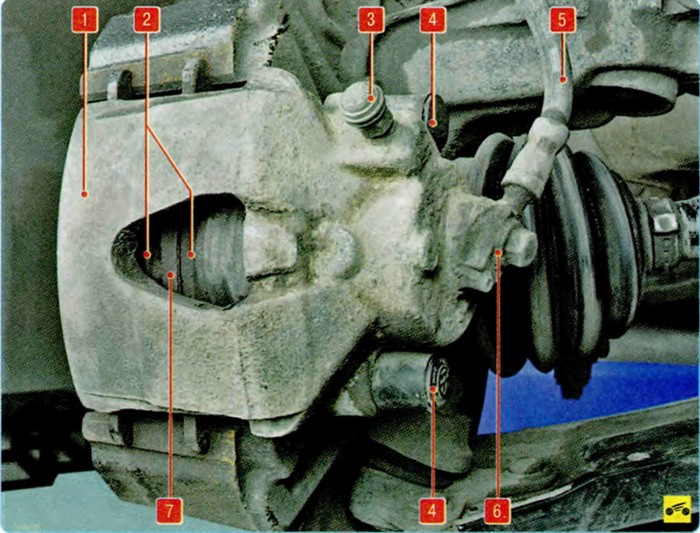
Rice. 1124. The brake mechanism of a forward wheel:
1 - a bracket; 2 - brake pads; 3 - air release valve; 4 - caliper guide bolt cover; 5 - brake hose; b - brake hose tip; 7 - brake disc.
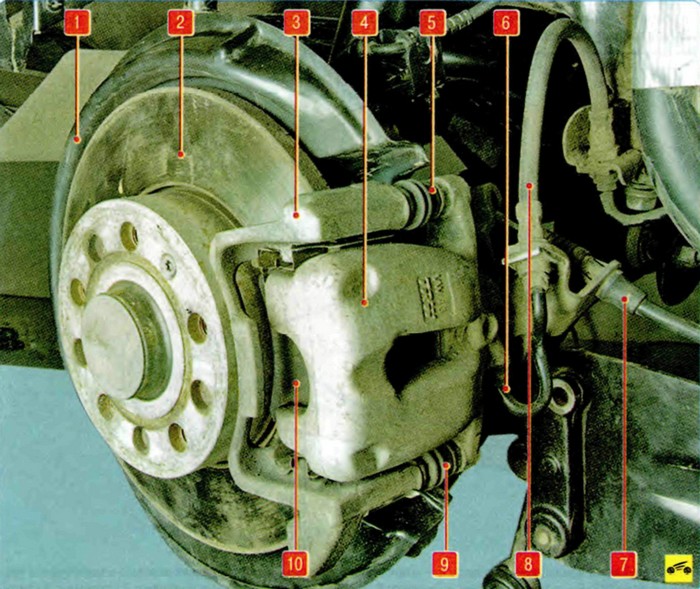
Rice. 1125. Brakes Skoda Octavia of the rear wheel:
1 - shield; 2 - brake disc; 3 - brake pad guide; 4 - brake caliper; 5.9 - protective covers of the guide pins; 6 - pipeline; 7 - parking brake cable; 8 - brake hose; 10 - brake shoe
In case of violation of the function of one brake circuit, the second circuit remains in working condition and the car retains its braking capacity by about 50%. In this case, the pedal travel is also lengthened by about 50%. The remaining circuit ensures safe braking of the vehicle.
Tank 6 (see Fig. 1122) is mounted on the main cylinder through rubber connecting bushings. The inner cavity of the tank is divided by a partition into three compartments. Two compartments feed two chambers of the main cylinder, and the third compartment feeds the clutch release hydraulic drive (in the variant).
When you press the brake pedal, portions of the master cylinder begin to move, the working edges of the cuffs block the compensation holes, the chambers and the reservoir are separated and the brake fluid is displaced.
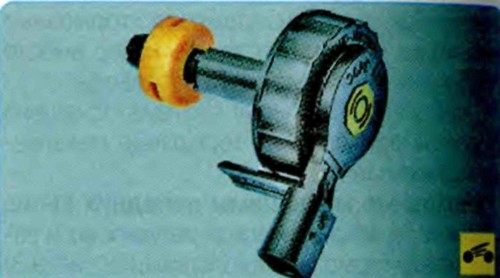
The brake fluid level sensor is installed in the reservoir cap. If the fluid level falls below the permissible level, the warning lamp for a malfunctioning brake system lights up in the instrument cluster.
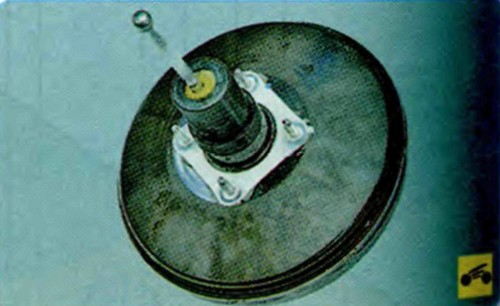
The vacuum booster is located between the pedal mechanism and the brake master cylinder. When braking due to vacuum in the intake manifold of the engine, the amplifier through the rod and piston of the first chamber of the main cylinder creates an additional force proportional to the force applied to the pedal.
The brake mechanisms of the rear wheels (Fig. 1125) are disc brakes with automatic clearance adjustment. The brake pads are actuated by a single hydraulic working cylinder. The optimal clearance between the disc and the pads is maintained according to the same principle as the brakes of the Skoda Octavia front wheels.
The working brake mechanisms of the rear wheels are combined with the mechanisms of the parking brake.

The vacuum electric pump is installed on cars with gasoline engines that comply with Euro-4 emission standards and automatic transmissions. The vacuum pump ensures the efficient operation of the vacuum brake booster. On vehicles with this power unit, after a cold start of the engine and with the gear engaged with the brake pedal depressed, the throttle valve is open so that a relatively small vacuum is created in the intake piping. The reasons for opening the throttle valve are the acceleration of heating of the catalytic converter after a cold start of the engine, which is necessary to comply with Euro-4 emission standards, and overcoming the resistance of the torque converter under the above conditions.
When the pump is turned on, the electric motor rotates the shaft with the rotor, as a result of which centrifugal forces press the movable blades against the working surface of the pump housing and seal the “measures” enclosed between them. In this case, the air enclosed between the blades and the stator surface moves from the inlet channel, to which the vacuum brake booster is connected, to the outlet channel. As a result of the eccentric position of the rotor shaft, the volume of the chambers and, accordingly, the compression of the intake air decreases.
The mechanically actuated parking brake consists of a lever mounted on the base of the body between the front seats, a front cable with an adjusting device and an equalizer, to which two rear cables are attached, and expanding levers installed in the rear wheel brake mechanisms.
The parking brake of the Skoda Octavia does not require special care. During current repairs, check the degree of wear of the teeth of the sector and pawls. Replace excessively worn parts.
If a break in the cables is detected, they must be replaced with new ones.
USEFUL ADVICE
Some drivers, in an effort to wear out the parking brake cables less, try to use them less often. Such "economy" leads to the opposite result: the cable, rarely moving in the shell, gradually loses its mobility, it jams, as a result, the cable breaks. Therefore, use the parking brake whenever necessary.
Source: http://skoda-octavia2.ru/index.php/tormoza-skoda-octavia.html
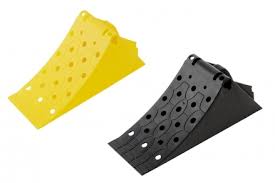
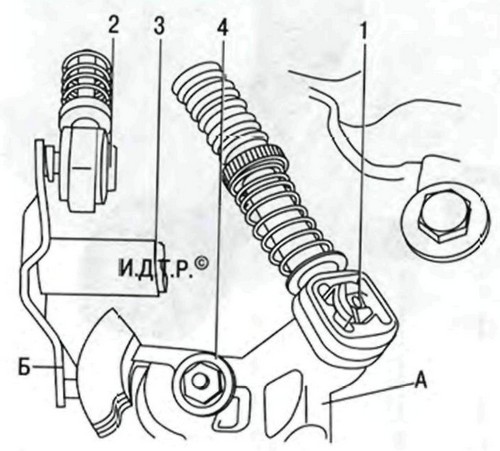
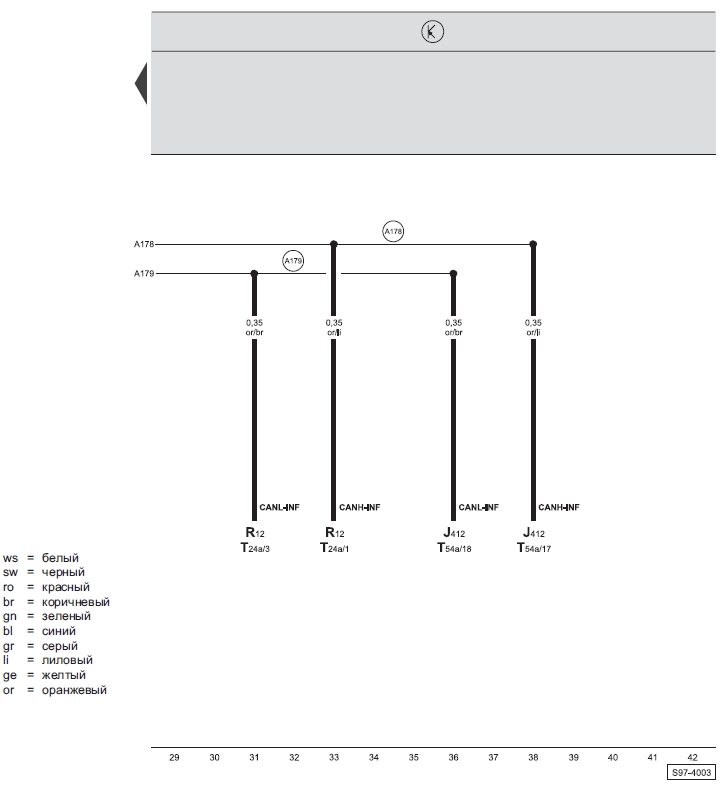
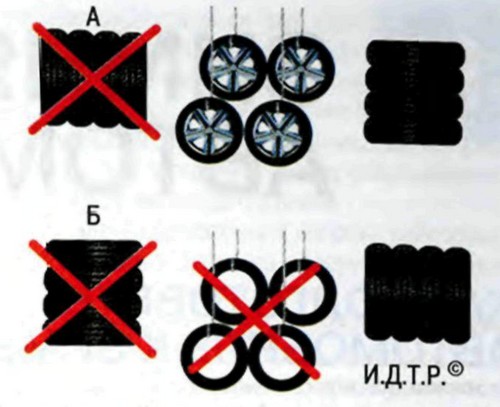

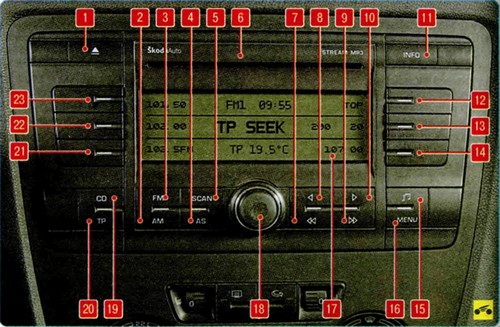
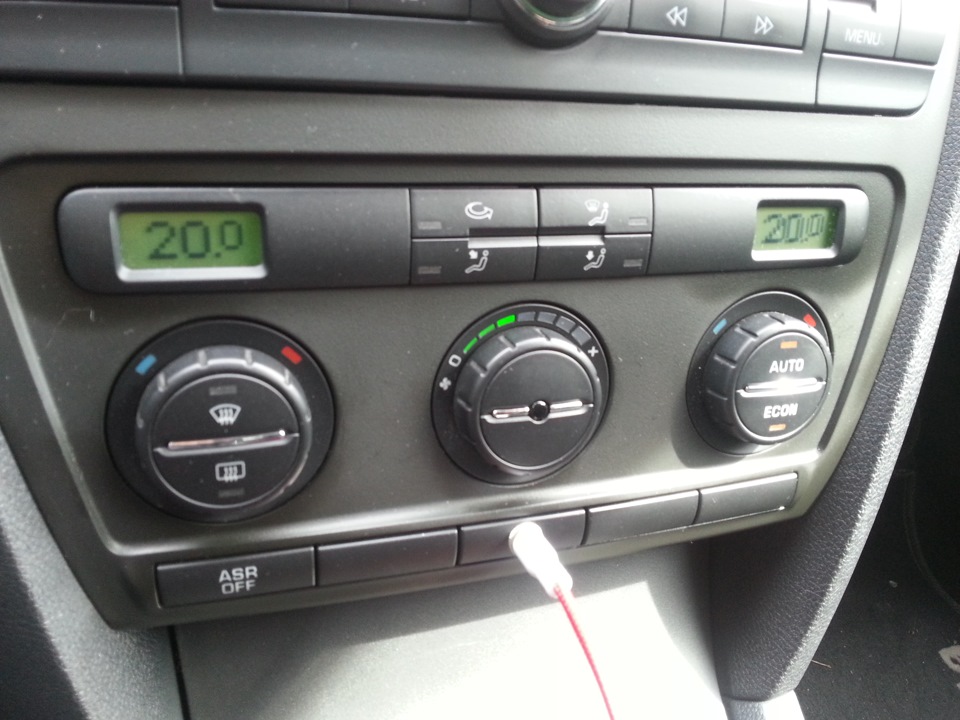
![1 generation [restyling] [2000 - 2010]](/uploads/Skoda_Octavia_2000_-_2010_.jpg)
![2 generation [2004 - 2008]](/uploads/Skoda_Octavia_2004_-_2012_.jpg)
![3 generation [2013 - 2017]](/uploads/Skoda_Octavia_2013_-_2015_.jpg)
